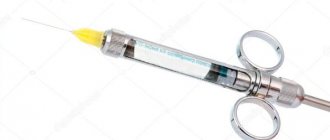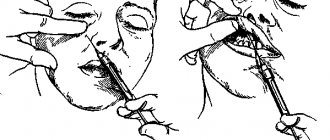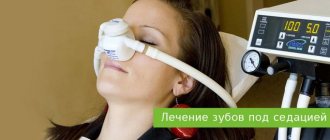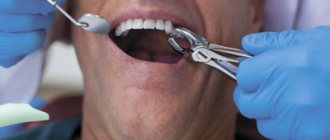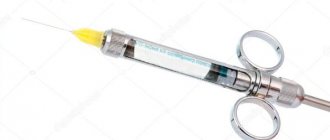Anesthesia plays a huge role in modern medicine. After all, thanks to it, doctors have the opportunity to perform operations and a number of special examinations that are accompanied by pain.
Modern anesthesia involves rather complex pain relief techniques. Therefore, for these purposes there is a certain doctor, who is called an anesthesiologist.
Spinal anesthesia
The largest percentage of pain relief occurs under general anesthesia, that is, anesthesia. However, it is also possible to perform local anesthesia. This type of loss of sensitivity involves anesthesia of only certain areas of the human body.
However, in certain situations and individual indications, another type of anesthesia is often performed, the name of which is “spinal anesthesia.”
What is spinal anesthesia?
This anesthesia technique represents a regional loss of sensation in the patient. In this case, there is a complete temporary “switching off” of any sensations in the area of the body located below the navel. This type of anesthesia is an excellent replacement for general anesthesia. The process of injecting a patient with spinal anesthesia is carried out by injecting a certain drug into the back, which turns off the nerves responsible for pain.
During spinal anesthesia, the patient “turns off” sensitivity in the area below the navel
The advantages of this method of pain relief are:
- minimal blood loss during the operation;
- the risk of postoperative blood clots and pulmonary thromboembolism is significantly reduced;
- reducing negative effects on the lungs and heart;
- no nausea or weakness;
- absence of pain in the postoperative period;
- the possibility of direct contact with the doctor during surgery;
- the opportunity to eat well after surgery.
Why is general anesthesia recommended?
Many years of clinical experience are aimed at achieving maximum comfort and safety of procedures. We use the latest anesthesia technologies and drugs that were developed and used not only for cosmetic surgery. They are designed for a smooth course of anesthesia and quick awakening. During this restful sleep you will feel absolutely nothing. This will allow the doctor to be completely focused on the operation. For surgeries lasting more than an hour, our anesthesia requires fewer medications. It is also characterized by rapid awakening and absence of nausea.
Technology of anesthesia
To ensure complete painlessness, anesthesia is administered into the cavity of the spinal column, located between the membranes of the brain and spinal cord. This area is filled with cerebrospinal fluid - cerebrospinal fluid. Thanks to the anesthetic entering this space, a complete “switching off” of the lower body is achieved. This result is achieved by blocking nerve impulses emanating from the nerve roots of the spine to the brain. Therefore, a person does not feel anything during the action of the drug.
An analgesic agent is injected into the subarachnoid space
Administering spinal anesthesia requires specialist technical skill as the process is not easy. In addition, spinal anesthesia is performed using medical instruments that reduce the risk of complications after anesthesia.
Such tools include:
- alcohol disinfecting cotton swabs for antiseptic procedures;
- two syringes, one of which contains a local anesthetic for a less sensitive spinal puncture. And the second syringe is filled directly with an analgesic agent for spinal anesthesia;
- a special needle for performing a spinal puncture. By the way, it is much thinner than the one used for epidural anesthesia.
Technique of infiltration anesthesia
The method of infiltration anesthesia was developed at the end of the 19th century, but the anesthetics used at that time were highly toxic.
The technique became more widespread after the introduction of novocaine into practice. This agent could be administered in larger volumes without significant risk of toxicity. The disadvantages of infiltration anesthesia at that time were: delayed development of anesthesia, the need for additional tissue infiltration during surgery, and the risk of toxic effects of the anesthetic. A.V. managed to eliminate these shortcomings. Vishnevsky, who proposed the technique of tight “creeping infiltration”. The method is still widely used in small operations. Features of the technique include the use of a weak solution of novocaine (0.25%) and infiltration of a large volume of anesthetic into fascial closed spaces. The anesthetic solution is injected into the tissue under increased pressure and spreads over a considerable distance within the fascial sheath, while the drug acts on the axons of neurons innervating the intervention area. High hydrostatic pressure promotes closer contact of novocaine with nerve endings. This leads to a rapid development of anesthesia and allows the surgeon to immediately begin the operation. In addition, thanks to the “creeping infiltration” method, hydraulic tissue preparation is ensured, facilitating such surgical procedures as the separation of adhesions, tumor isolation, and others.
The process of spinal anesthesia
After completing all the above doctor’s instructions, you can proceed directly to the anesthetic injection. To do this, the patient must provide the doctor with good access to the spine, taking a position lying on his side, or sitting, with his back bent as much as possible.
This is followed by treatment of the anesthesia injection area with antiseptic drugs and an injection of local anesthetic from the first syringe. Then the anesthesiologist administers the anesthetic, based on the rules for the technique of administering this anesthesia - specifically into the subarachnoid space.
The required dosage of the drug is calculated by the anesthesiologist in advance. It is determined based on an analysis of the individual characteristics of the human body: height, weight, age.
It is worth noting that the puncture site is usually located between the II and III vertebrae of the lumbar spinal column, but it is also acceptable to administer an anesthetic up to the V vertebra. The choice of location for spinal anesthesia depends on the individual structure of the spine, the presence of previous injuries or surgical interventions.
Spinal anesthesia is most often administered between the second and third or third and fourth lumbar vertebrae
Types of infiltration anesthesia
Conventionally, two types of infiltration anesthesia can be distinguished: direct and indirect. With direct anesthesia, the drug is injected directly into the surgical area. This type of anesthesia is used during soft tissue operations.
With the indirect (diffuse) type of infiltration anesthesia, the anesthetic is administered at some distance from the area that needs to be anesthetized. By diffusion, the solution reaches the tissues in the intervention area. For example, introducing an anesthetic solution around the surgical field when opening an abscess or injection under the periosteum when numbing a tooth. The effect of the drug is determined not only by the pharmacokinetic properties, concentration and amount of solution, but also by the condition of the infiltrated tissues (local inflammation, scar-adhesive process reduce the analgesic effect).
Feel
After direct administration of the drug, a person gradually begins to feel heaviness in the legs or a slight tingling sensation. This indicates that the administered drug is beginning to work. After a few minutes, sensitivity completely disappears. Before surgery, the doctor must test for loss of sensitivity. If suddenly a person feels an unpleasant sensation, more like an electric shock, you should immediately tell a doctor about it.
In some situations, longer spinal anesthesia may be required. In this case, a special instrument, a catheter, is placed in place of the previous puncture for additional administration of the medicine.
Anesthesia technique
A solution of novocaine is injected intradermally with a thin needle, warmed to body temperature. As a result, a “lemon peel” is formed at the site of the upcoming cut. Then a thicker needle is used to infiltrate the subcutaneous tissue and create a subcutaneous novocaine infiltrate. After this, the skin and subcutaneous tissue are dissected to the aponeurosis. Following this, the subgaleal space is tightly filled with novocaine solution, ending with the opening of the aponeurosis. If the intervention requires it, subsequent anesthesia of the peritoneum, mesentery or pleura, and the root of the lung is performed. In all cases, when performing infiltration anesthesia, the surgeon adheres to the rule - infiltration with an anesthetic must precede an incision with a scalpel. Novocaine blockades proposed by A.V. are based on a similar principle. Vishnevsky. It also uses tight filling of anatomical “cases” with anesthetic, which does not require direct application of the drug to the nerve trunks.
Anesthetics for anesthesia
For spinal anesthesia, agents with various properties are used. Each of these drugs gives a different effect in terms of duration of exposure. Patients with allergic diseases should not worry: there are a lot of options for administered medications, and the doctor will definitely replace a drug that is unsuitable for the individual body with one with a similar effect. Here are some of the medications that are used for spinal anesthesia: Narolin, Novocaine, Mezaton, Fraxiparine, Lidocaine, Bupivacaine and many others.
"Mezaton"
For your information, the table below shows the active ingredients used in spinal anesthesia drugs, their dosages and the duration of action of each of them. Thanks to this table, the patient can determine whether he is allergic to a particular drug and whether the dosage is appropriate for him.
| Medicine | Concentration of solutions, (%) | Maximum dose, (mg) | Duration of action (minutes) |
| Procaine hydrochloride | 0.25 or 0.5 | 500 | 40-60 |
| Lidocaine | 2-5 (hyperbaric solution) | 15-100 | 60-90 |
| Tetracaine hydrochloride | 0.5 (hypobaric, isobaric or hyperbaric solution) | 5-20 | from 180 (hyperbaric solution) to 270 (hypobaric solution) |
| Bupivacaine hydrochloride | 0.5 (isobaric or hyperbaric solution | 10-20 | 90-150 |
| Artikain | 5 (hyperbaric solution) | 100-150 | up to 120 |
Advantages of the method
- The rapid onset of the effect of loss of sensitivity and blocking of nerve impulses.
- It is successfully used during caesarean section or to ease contractions during childbirth. Thanks to the safe effect on the patient’s body, the mother in labor does not have to worry about the health of the baby.
- A much smaller dose of the drug enters the patient’s body compared to other types of anesthesia.
- By using a thin needle when injecting the drug, the risk of internal damage is minimized.
- This anesthesia technique involves the muscles being as relaxed as possible, which greatly helps the surgeon during the operation.
- There is minimal intoxication of the body when the drug is administered, since the percentage of the anesthetic entering the blood is in isolated cases.
- The analgesic effect does not affect the respiratory system; therefore, problems associated with the lungs are automatically excluded, as is the case with general anesthesia.
- The patient remains conscious, which helps to immediately eliminate complications, since direct contact is maintained between doctors and the patient during the entire surgical process.
- Minimal risk of complications after puncture due to the simplicity of the anesthetic injection technique.
Spinal anesthesia has many advantages
Local anesthesia in dentistry
In dentistry, the following types of local anesthesia are distinguished:
- Appliqué
- Infiltration
- Conductor
- Intraosseous
- Intraligamentary (intraligamentous)
- Stem
- Combined.
- Computer
All modern methods of pain relief in dentistry have their own characteristics, indications and contraindications.
In pediatric dentistry, the same types of local anesthesia are used, but for very young patients (2-3 years old), who simply will not allow the dentist to work, we give short-term anesthesia, for example, with propofol. This is a very modern and safe drug.
Application anesthesia
Allows you to anesthetize superficial soft tissues: skin and mucous membranes to a depth of approximately 1 - 3 mm. The drug quickly penetrates the tissue and temporarily disables the nerve endings located there. During the procedure, a high concentration of local anesthetic is used in the form of a gel, aerosol or emulsion. The drug is applied to the dried mucous membrane or the solution is sprayed onto it using a spray bottle.
Local topical anesthesia in dentistry (in other words, anesthesia without an injection) is used:
- to numb the needle point before injecting;
- for removing baby teeth;
- when removing small soft tissue tumors.
Pain relief for stomatitis in children using special pastes and gels is also an application.
Infiltration of tissues with anesthetic solution
Infiltration is used in dentistry much more often than other types. Tissue anesthesia occurs using a syringe or needleless injector. Sensitivity to pain is switched off after just a few minutes, and the duration of exposure depends on the type of anesthetic, its dose, and the presence of vasoconstrictor components in the composition.
The method, in addition, has some variations: intraosseous and intraligamentary anesthesia, they are also quite often used in dentistry. For them you need to use a special syringe.
Conductive anesthesia in dentistry
Conduction dental anesthesia is used much less frequently than infiltration anesthesia. An anesthetic solution is injected near the peripheral nerve trunk, which numbs the entire area for which it is responsible. The desired effect occurs 10-15 minutes after the injection and lasts for 1-2 hours.
It is used when you need to numb a large area at once or if infiltration does not work. Unlike infiltration anesthesia, a smaller amount of anesthetic is used here, but in a higher concentration.
Torusal and mandibular anesthesia are performed on the lower jaw.
In this case, the lower alveolar and lingual nerves are switched off, so during the action of the anesthetic the patient feels numbness in the entire half of the lower jaw, lip, chin and tongue. Tuberal anesthesia in dentistry is often accompanied by the formation of a hematoma. It was this inconvenience, combined with the complexity of the technique and the high likelihood of complications, that forced dentists to abandon this type of anesthesia.
Intraosseous
To administer an anesthetic solution intraosseously during injection, the doctor perforates the dense outer cortical plate of the jaw bone and injects the solution into the spongy substance itself, where the terminal branches of the dental plexus are located. The effect appears within 1-2 minutes, the teeth and alveolar process are anesthetized. This manipulation is performed using a special syringe with a short, large-diameter needle and is a type of carpule anesthesia in dentistry.
Intraligamentary
Intraligamentary anesthesia involves the dentist injecting a solution into the periodontal ligament, which connects the tooth root to the bone alveolus. In this way, you can anesthetize only one tooth and do it with a record small amount of anesthetic, which is why this type of anesthesia remains very popular. It should be noted that the injection into the periodontium is quite painful and minor discomfort remains in the tooth for 24 hours after it is performed.
Trunk anesthesia in dentistry
This type of anesthesia is rarely performed in dentistry. This technique is also called (according to the author) “according to Bershe-Dubov”. This technique is used for severe pain in a patient, for the treatment of serious injuries and operations on the jaw and zygomatic bone, as well as for neuralgia, and only in a hospital setting.
An anesthetic injection is given at the base of the skull (brain stem), and the pain relief spreads through both trigeminal nerves and their branches. This allows you to immediately disconnect the mandibular and maxillary nerves. The effect of stem anesthesia lasts quite a long time.
Combined anesthesia
Combined or sedative anesthesia in dentistry is used more and more often. In order for the treatment to be not only painless, but also completely comfortable, it is not enough to simply eliminate pain, it is necessary to cope with fear and emotional stress. It is this effect that potentiated analgesia can achieve. It is a combination of superficial sedation and local anesthesia, carried out with the participation of an anesthesiologist. This is one of the best types of anesthesia for children in dentistry at the moment.
Superficial sedation is a state of stunning, slight depression of consciousness. In this case, the patient does not experience fear or anxiety before the upcoming intervention, but remains conscious. Of course, the advantage of this pain relief is not only its comfort. Anxiety and fear, among other things, cause a significant decrease in the pain threshold. That is, eliminating negative emotions allows you to achieve a good level of pain relief with smaller doses of anesthetic.
What is computer anesthesia?
Computer-controlled anesthesia is carried out by a special electronic system, which consists of a system unit and a handpiece. The needle has a special design that allows you to pierce soft tissue and perforate the cortical plate of the bone absolutely painlessly. Another advantage is the dosed administration of an anesthetic drug: the amount and speed of this process is controlled by a computer.
Carpule anesthesia
To perform carpule anesthesia in dentistry, special instruments are used - carpule syringes. They are a reusable metal device that has a body, a plunger and a needle that is much thinner than a regular injection needle. The drugs are supplied in special carpules and placed in the syringe body.
Negative consequences of spinal anesthesia
In order for the patient to decide to undergo spinal anesthesia, he needs to familiarize himself in advance with information about the disadvantages of this method of pain relief.
- During the medication administration process, the patient's blood pressure may drop sharply. Therefore, hypotensive patients are given drugs that increase blood pressure in advance - of course, if necessary. For hypertensive patients, this consequence can only have a positive effect.
- The time of loss of sensitivity is directly related to the dose of the drug. If sensitivity returns before the required time, and there is not enough time to complete the operation, the patient is immediately placed under general anesthesia. The spinal anesthesia method does not involve constant support of the anesthetic in the body; most often it is administered once. However, do not worry, since modern medicine uses medications that last up to six hours, which in most cases allows the surgeon to carry out all the manipulations on time.
- Headaches are a frequent companion of the patient after recovery from anesthesia.
Indications for using spinal anesthesia technique
- Surgery of the legs or perineum.
- Reducing the risk of thrombosis in older people during leg surgery.
- Due to the impossibility of administering general anesthesia for lung diseases, both acute and chronic stages.
- Pinched sciatic nerve.
- Radicular syndrome.
- The need to reduce the tone of intestinal muscle tissue during operations on the gastrointestinal tract.
- The need to relax the walls of blood vessels in people with heart problems, with the exception of hypertensive patients and patients with heart valve problems.
There are many indications for the use of spinal anesthesia.
Indications for general anesthesia
In some cases, patients are prescribed only general anesthesia. Such situations include large-scale surgical operations when the doctor is unable to complete them in a short period of time. In cases of dental treatment, general anesthesia is prescribed when the patient needs to have a large number of teeth removed or many implants installed.
Important! Along with this, this anesthesia is prescribed to people with allergies to local anesthetics, patients with a gag reflex during dental therapy, as well as those patients who will undergo surgery on organs above the navel.
Ultrasound anesthesia
When performing anesthesia, it is very important to choose the right injection site, since a mistake can lead to serious complications. This is especially true for conduction anesthesia, where the drug must be in close proximity to the nerve, but the needle cannot touch it. Ultrasound successfully helps determine the site of anesthetic injection. Under the control of an ultrasound machine, it is possible to calculate down to the millimeter the location of the needle and its proximity to the nerve, thereby ensuring the most effective and safe anesthesia of the desired area.
Contraindications to the use of spinal anesthesia
Complete contraindications for spinal anesthesia are:
- direct refusal of the person to undergo the procedure;
- problems with blood clotting - to exclude volumetric blood loss;
- infection or inflammation at the site of future anesthesia injection;
- critical conditions of the patient in the form of shock, major blood loss, sepsis, pulmonary and cardiac dysfunction;
- allergy to all types of anesthetics used for puncture;
- meningitis and other infectious diseases of the nerves;
- hypertension;
- herpes;
- arrhythmia.
If there are absolute contraindications to spinal anesthesia, doctors will have to use a different method of pain relief
Relative contraindications, when the benefit significantly outweighs the harm caused to the patient by spinal anesthesia, include:
- changes in the structure of the spine, both congenital and acquired due to injury;
- the patient was given a pre-prognosis for heavy blood loss during surgery;
- fever associated with infectious diseases;
- multiple sclerosis, epilepsy and other diseases of the nervous system;
- mental disorders (when there is a possibility that the patient will not be able to lie still during surgery);
- use of aspirin shortly before the appointment of spinal anesthesia due to an increased risk of blood loss due to the properties of this drug;
- the likelihood of increased surgical time;
- childhood.
Why is anesthesia needed?
It would seem that anesthesia is needed for pain relief. However, that's not all. Anesthesia allows not only to relieve a person from unpleasant sensations, but to control his condition during surgery. The fact is that the human body reacts to any such intervention very actively - with heartbeat, increased heart rate, changes in pressure, which is completely undesirable during surgery. Anesthesia blocks such reactions of the body and during the operation a normal heartbeat and a calm state are maintained. In addition, thanks to anesthesia, the person does not seem to remember about the operation. Anesthesia relieves the patient of serious stress. When the patient does not remember either pain or fear, rehabilitation proceeds faster.
Frequently asked questions from patients before agreeing to spinal anesthesia
How will I feel after the anesthesia is administered?
Answer. A couple of minutes after the injection of spinal anesthesia, heaviness in the lower extremities, slight numbness and warmth may be felt. After 15 minutes, the legs will be completely motionless.
How will I feel during the operation?
Answer. During a prolonged operation, a feeling of discomfort may occur due to the long static posture of the body. However, no pain will be felt. Also, discomfort during surgery can be caused by strong touches, stretching of the legs during the doctor's manipulations, or ambient noise. At the request of the patient, the anesthesiologist can put him into a state of light sleep for better comfort. At the same time, the specialist monitors his physical indicators: pulse, blood pressure, breathing and consciousness.
How will I feel after the surgery?
Possible side effects of spinal anesthesia
First of all, it should be noted that the number of side effects with this type of anesthesia is much less than after general anesthesia. Therefore, the risk of complications is reduced to a minimum and is extremely rare.
Possible complications are associated with pathologies present in the patient’s body, as well as age and bad habits.
We should not forget that all manipulations in anesthesiology, up to the installation of a regular IV, carry a certain risk. However, by strictly adhering to all doctor’s prescriptions, a person in most cases manages to avoid negative consequences.
Possible complications after anesthesia include:
- headache. This negative consequence most often appears due to the fact that after anesthesia a person begins to actively move. Statistics show 1% of the total number of complications. This pain syndrome goes away on its own within a couple of days. However, during this period it would not be amiss to measure blood pressure and act based on the tonometer readings. The main rule in this case is compliance with bed rest in the postoperative period;
- decrease in blood pressure. This negative factor is caused by the introduction of an anesthetic. As a rule, it does not last long. To normalize blood pressure, special intravenous solutions are administered and it is recommended to drink more fluids. This condition occurs in 1% of patients;
- pain in the anesthesia puncture area. The discomfort goes away within 24 hours and does not require additional treatment. If the patient cannot tolerate the pain, then you can take a Paracetamol or Diclofenac tablet;
- delay in the process of urination. A common occurrence that does not require therapy and usually resolves on the second day after surgery;
- neurological complications. An extremely rare phenomenon characterized by loss of sensation, muscle weakness and tingling in the lower part of the body lasting up to two days. If this problem persists for more than three days, you should consult a doctor.
There is always a certain risk of complications after spinal anesthesia, but fortunately it is extremely small
Preventing complications
In order to eliminate the risk of developing negative consequences, it is necessary to strictly follow the recommendations of the anesthesiologist.
- 6-8 hours before surgery, do not eat or drink any liquids.
- Do not smoke tobacco products 6 hours before surgery.
- Do not wear makeup or polish your nails before surgery.
- Remove contact lenses from your eyes and remove all removable dentures, if any, from your mouth. It is necessary to inform the anesthesiologist in advance about the presence of ocular prostheses if they are worn.
- Remove rings from your fingers, earrings from your ears, chains from your neck, as well as other jewelry items. For believers, it is permissible to leave the cross on the body, but not on a chain, but on a braid.
Compliance with these recommendations significantly reduces the risk of complications.
The main thing is that the patient informs the anesthesiologist about all his diseases, previous injuries and surgical interventions, and also talks about the presence of possible allergies to medications or intolerance to any drugs. The specialist also needs to know whether the patient is taking medications. Collecting this information is the key to successful spinal anesthesia. This will also help prevent negative side effects after anesthesia.
Before administering anesthesia, the patient must inform the doctor about previous or existing diseases, taking any medications, injuries and other features
Before the operation, the patient should rest well and get enough sleep. It would be a good idea to spend some time in the fresh air and calm down. These simple steps will help you psychologically tune in to a positive wave, which will greatly facilitate the process of surgical intervention, and will also help the body recover faster after its completion.
What anesthesia options are there?
Local anesthesia.
Local anesthesia is performed by injecting a solution of Lidocaine (Xylocaine, Marcaine) into the tissue. The surgical site is punctured and it blocks the formation and passage of a nerve impulse. What do you feel? Numbness of tissues.
In fact.
In fact, today's surgeons rarely use local anesthesia for cosmetic surgery. This is due to the specifics of the operation - intervention on the bone requires general anesthesia, and the fact that it is simply inconvenient to work in an environment where a patient is looking at you trembling with fear. After all, rhinoplasty is a jewelry operation. Therefore, general anesthesia is most often used during rhinoplasty.
General anesthesia.
General is a type of anesthesia in which the patient’s consciousness is turned off and the patient falls into deep sleep.
Intravenous anesthesia.
Intravenous anesthesia can be characterized as physiological sleep. Drugs are injected into a vein using special dosing devices, which ensure a uniform, constant flow into the body. With this anesthesia, a person breathes on his own. After the operation is completed, the effect of the drugs wears off and the patient wakes up.
How do you feel during general anesthesia?
You don't feel anything. Modern drugs for general anesthesia induce temporary, easily controlled sleep that closely resembles natural sleep. Modern general anesthesia means easy, natural falling asleep, smooth, stable sleep during surgery, and quick and calm awakening. This applies to both intravenous and endotracheal anesthesia. The patient is not allowed to feel the disgusting process of inserting a tube into the trachea. In modern conditions, a person is first gently put to sleep, and then all the manipulations are done. So this article is perhaps the only chance to find out what will actually happen to you.
Will I feel nauseous?
The anesthesia that we use for our patients is practically not accompanied by nausea (in less than 5% of cases, compared to 30% according to statistics). Special medications are used that reliably block nausea. This is absolutely important: “Do not eat or drink 8 hours before surgery.”
Your anesthesiologist.
If you are undergoing general anesthesia, it is important that your surgeon conducts the operation together with a qualified anesthetist. A meeting with this specialist occurs even before the operation. The main task of the anesthesiologist is to assess your readiness for surgery and ensure safety during anesthesia. The anesthesiologist will not take risks and, if he has doubts, he will postpone the operation, even if this causes dissatisfaction with the surgeon and the patient.
The anesthesiologist is interested in what you were sick with, whether you have a cold or high blood pressure, whether you have had previous operations, allergic reactions, etc. Your physical condition is also important to him, whether you smoke or take medications. The anesthesiologist is obliged to study your card (in which the surgeon most likely described the upcoming intervention), test results and electrocardiogram. Blood tests will help identify hidden inflammatory processes, a tendency to bleed, the presence of diabetes, and disturbances in the functioning of internal organs. An electrocardiogram will show the state of the heart. And only after this, based on the examination data and the surgical plan, the anesthesiologist will choose the most suitable method of anesthesia for you.
Why do you need to tell the anesthesiologist about the medications you are taking?
In addition to their main effects, most medications also have side effects that should be taken into account. When used together, drugs may change their activity and duration of action. For example, taking regular aspirin affects blood clotting; sleeping pills and sedatives can change the body's response to the administration of painkillers.
During the operation.
The anesthesiologist conducts the operation together with the operating doctor. During the entire operation, using modern monitoring equipment, continuous monitoring of pulse, blood pressure, respiration, and the activity of the body as a whole is carried out. The anesthesiologist must know your weight, your diseases, must constantly monitor your heartbeat, breathing, blood pressure, level of anesthetic, etc. Must monitor the process of awakening after anesthesia, prescribe medications after surgery, and monitor how rehabilitation is progressing.
When will I wake up?
As soon as the operation is completed, your smooth awakening will begin in the recovery room. A plastic surgeon and a nurse will be in the room. For greater comfort, you will be carefully covered. Your mouth and throat will feel dry. There will be monitors at the head of the bed to monitor your condition.
After general anesthesia, it may seem to the patient that there was no operation at all, that she or he simply fell asleep for 5 minutes and now woke up with the anesthesiologist in front of his nose.
Usually the doctor asks the patient some question to make sure that the patient has regained consciousness. When anesthesia is completed, observation and treatment continues. The initial rehabilitation period may be accompanied by fever, chills, nausea and drowsiness. Or maybe just drowsiness. Or it may not be accompanied by anything at all. In any case, the anesthesiologist and the nurse on duty provide the patient with everything necessary for the body to recover as quickly as possible.
Will the anesthesiologist be absent during my surgery?
The anesthesiologist will be constantly with you at all stages of the operation until you wake up. All his attention will be occupied exclusively with your operation. The presence of unauthorized persons, including other doctors not involved in the operation, is excluded.
Is there a risk from anesthesia?
All operations performed under anesthesia carry some risk, which directly depends on many factors, including the type of operation and especially the patient's health. But in aesthetic surgery this risk is practically absent. The fact is that the plastic surgeon and anesthesiologist make every effort to prevent possible problems. Statistically, undergoing surgery is much safer than driving a car. An anesthesiologist working in aesthetic surgery is always a professional.
Will I be connected to a monitor?
Connection to the most modern monitoring allows your anesthesiologist and doctor to perform operations with the maximum level of safety. You will have an intravenous line inserted to give you fluids and medications. To monitor blood oxygen saturation, a sensor is placed on the finger. In addition, sensors are used to measure temperature and monitor the cardiogram. Some surgeries (such as abdominoplasty) use urine output monitoring. Before the operation itself, an elastic bandage will be applied to the lower legs to improve blood circulation in the legs during the operation.
What about smoking, drinking alcohol or taking medications?
Smoking harms your body much more than you think. This applies equally to passive smoking. Since smoking affects your lungs, heart, spasms blood vessels, and affects the healing process, nicotine can disrupt the effect of anesthetic drugs during surgery. All this can significantly affect the outcome of the operation. Therefore, taking care of his reputation, the doctor does not operate on candidates for facelift (circular facelift) and abdominoplasty in cases of non-cessation of smoking (at least a month before surgery). It is advisable not to smoke in the early postoperative period. This also applies to drinking alcohol before surgery.
Are there any restrictions on taking vitamins and traditional medicine?
The purpose of vitamins, nutritional supplements and traditional medicine is to help us live a healthy and long life. Their effect is mainly characterized by their effect on blood viscosity, protecting us from heart attacks and strokes. But this can also complicate the course of your anesthesia, surgery and healing. It is imperative that you notify your plastic surgeon if you are taking any of the above. You should stop taking vitamins, nutritional supplements, traditional medicine and homeopathic medicines at least 3 weeks before the planned operation.
Let's sum it up
Spinal anesthesia is an extremely safe method of pain relief. If the patient is faced with a choice between spinal and general anesthesia, then it is worth giving preference to the first - firstly, it does not require long preparation, and secondly, the recovery period after such anesthesia is short and, moreover, quite comfortable. There is no need to be afraid of this type of anesthesia - after a few hours, sensitivity is completely restored, and the patient can forget about any discomfort.
